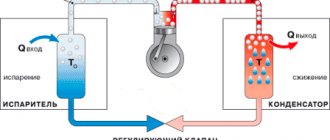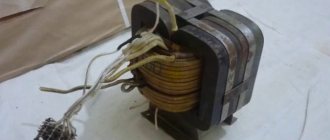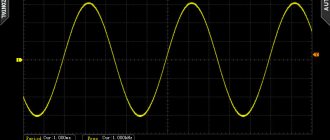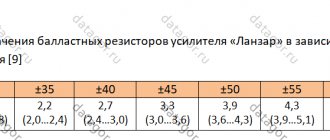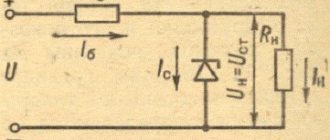A stabilizer is a device that is an electrical device that is used to equalize network voltage fluctuations when supplying current to equipment such as computers, air conditioners, pumps, etc.
Why do you need a voltage stabilizer? The regulator is mainly intended:
- protect electrical equipment from various threats such as voltage fluctuations, high and low voltage;
- disconnect equipment from poor-quality power supply when voltage thresholds increase or decrease;
- maintain voltage at the proper level.
This device has many unique features that allow you to save energy, influence productivity and increase the reliability of equipment. The main parameters of the electrical network are displayed on the device’s display; being always aware of them means being in control of the situation. The turn-on delay function provides a respite and stabilizes the power before being supplied to the load, therefore increasing the service life of the devices.
And yet, why do you need a stabilizer? Its use represents the most affordable and effective measure of energy conservation, preservation of appliances from failure and peace of mind for household members.
Some tips for choosing a stabilizer
If the device is chosen correctly, then you can always rely on it and trust it. If you don’t really understand technology, you can rely on the seller’s suggestions and advice on choosing a voltage stabilizer. A professional will recommend to start:
- determine the power, type of stabilizer and operating voltage range;
- identify and analyze the problem: increased, decreased or abruptly changing voltage in the power supply network.
Based on the data received, then proceed to select a device.
How to correctly calculate the power of the device? Ideally, you need to determine which is the most powerful consumer in the power supply circuit. Let’s say the electrical receivers are a pumping station with a power of 1.5 kW, a sauna with a power of 10 kW, plus some other device with high energy consumption. All values in kilowatts must be added up to obtain the required power of the device.
The stabilizer is selected with a small power reserve (20%), especially if the circuit contains equipment with a large starting current. We are talking about electric motors and pumps, which, when starting, consume more energy than in normal mode.
The power reserve ensures a long life of the device, thanks to the gentle operating mode, and creates reserve potential for connecting new equipment.
When choosing a stabilizer, you also need to take into account service, because the device should be connected correctly and efficiently, as well as take advantage of the warranty period and be repaired in case of malfunction.
Types of stabilizers and their areas of application
Today, several types of stabilizers are sold on the electrical market, among which are devices operating on the basis of an autotransformer and products based on transformerless double energy conversion technology. Let's look at the features and capabilities of each type of product.
| Stabilizer type | Scheme of work | Stabilization features |
| Autotransformer | These devices include relay, electromechanical, thyristor and triac voltage stabilizers. The products have a similar principle of voltage correction, which is performed by a switching unit (depending on the type of stabilizer, it can be a relay, mechanical drive or electronic keys), switching to the winding of the autotransformer that is capable of providing the output voltage as close as possible to the nominal value. | The more windings an autotransformer has, the smoother and more accurate the voltage regulation is. On average, for such devices the voltage deviation from the nominal value ranges from 2 to 10%. However, such accuracy may not be sufficient for particularly electrically sensitive types of loads. The response to network fluctuations occurs with a slight delay (from 5 ms), which is why the device output may experience increased or decreased voltage. Another disadvantage of autotransformer models is the lack of network distortion correction. |
| Double conversion | These stabilizers include inverter models, which are considered new generation devices. They do not have an autotransformer and switching blocks. Their voltage correction is performed through double electronic conversion: the input alternating voltage is first rectified into direct voltage, and then, using an inverter, it is converted back into alternating voltage, but with reference characteristics. | These stabilizers are capable of adjusting the input voltage instantly (in 0 ms) during network fluctuations in a fairly wide range (90-310 V). At the same time, the output signal has high accuracy: its deviation from the nominal value is no more than 2%. The products are guaranteed to provide the load with ideal sinusoidal voltage, regardless of network distortion. Inverter models are so far the only stabilizers that ensure uninterrupted operation of the load during short-term network outages (up to 200 ms). |
The scope of use of stabilizers is determined by their technical capabilities. Autotransformer stabilizers are used mainly to protect electrical equipment that does not require power quality, for example, lighting devices, television equipment, kitchen appliances and power tools without electric motors. Inverter models, due to their high characteristics, are suitable for protecting any type of load and are used in the most unstable electrical networks.
How to choose the right voltage stabilizer for your home?
You can use the simplest option: determine the power consumption from the network based on the rating of the input circuit breaker in the apartment panel. In this way, the throughput of the machine and the maximum possible power consumption for household needs are determined.
Let's give a simple example. How to choose a 220 V voltage stabilizer for your home if there is an S40 machine at the input. With such a rated current, you can get no more than 10 kW from the network. Based on the calculated data, the device is selected.
Today, low voltage in the network is a very pressing problem and the best way to solve it is to purchase a stabilizer that will protect all equipment in the house from failure. To choose the right device, you first need to understand its varieties, as well as the advantages of each design option.
Improving stabilizer parameters
A simple compensation voltage stabilizer circuit can be improved by replacing resistor R1, which powers transistor VT2, with a current stabilizer circuit. This power supply method can significantly increase the stability of the DC amplifier.
In cases where high temperature stability of the Compensation Voltage Stabilizer and low time drift are required (especially at low output voltages), differential amplifier circuits are used. To improve the quality of the output voltage, the DC amplifiers of the stabilizer use operational amplifiers, which have a high gain and low temperature drift. The operational amplifier can be powered directly from the output voltage of the stabilizer.
Current stabilizer circuit. Connection of pins: 1 – to the VT1 collector, pin 2 – to the VT collector. Differential amplifier circuit. Connecting the terminals: 1 – to the emitter VT1, 2 – to the base VT1, 3 – to the cathode of the zener diode VD1, 4 – to the anode of the zener diode VD1, 5 – to the voltage divider.
Types of protective devices
The most popular types of stabilizers today are:
- electronic,
- electromechanical.
Electronic voltage stabilizers are devices of the best quality. Due to the absence of mechanical parts, they are characterized by a long service life, at least 15 years, and fairly high reliability. Can be selected according to the operating voltage range for almost any task.
Electromechanical voltage stabilizers are characterized by low operating speed, a narrow voltage range, but good overload capacity.
Useful information about voltage stabilizers regarding high accuracy
Many people try to choose a device with maximum stabilization accuracy, up to 0.5%. However, as a rule, a deviation of 10–15 V is considered normal operation for most equipment. And only in rare cases does the equipment fail to work or become capricious due to such deviations. Most of the stabilizers offered on the market provide exactly this mode of operation.
A common misconception among buyers is that the purchased device with high stabilization accuracy is a guarantee of stable voltage and no flickering of light. In fact, it turns out the other way around: the greater the accuracy of the device, the more often it switches, adapting to the input network, which is why the light bulbs do not stop flickering. This applies to incandescent and halogen lamps.
When installing a triac and relay type stabilizer, the flickering of the light bulbs will be completely preserved. The only exceptions are stabilizers with smooth signal adjustment. This applies to new developments of stabilizers such as Voltaire. When choosing a regulator, it is advisable to follow the recommendations from the manufacturer or professionals. To be sure, you can also read positive and negative reviews on the Internet for a specific model or brand.
Voltage stabilization using a servo drive
In the 1960s, servos began to actively spread - special electric motors, the mechanism of which could rotate at different angles and maintain the required position.
In the same years, the servo drive began to be used in voltage stabilizers. Thus, in 1961, an electromechanical stabilizer was patented, the power of which consisted of an adjustable autotransformer, a movable current-collecting contact driven by a DC motor and an auxiliary voltage source. The device made it possible to automatically stabilize the mains voltage without distorting the shape of its curve.
Today, electromechanical stabilizers are still produced and, despite the variety of models, they have a similar operating principle - the control board compares the voltage value at the input of the product with the set reference one. If these two parameters differ, a servo drive with a graphite slider, roller or brush (depending on the specific stabilizer model) moves along the winding of the autotransformer and connects to the circuit a number of turns sufficient to obtain an output voltage as close as possible to the reference value.
This operating principle is associated with significant disadvantages. We are talking, first of all, about the low response speed - when a network deviation occurs, the servo drive requires a certain time to move the current collector to the required position. In addition, rapid mechanical wear of moving parts necessitates their periodic replacement.
Noise when moving the servo brushes, possible sparking during operation, and a bulky design create additional difficulties during domestic use of these devices.
More information about electromechanical stabilizers can be found in the article “Electromechanical voltage stabilizers.”
Which one to choose: single-phase or three-phase?
If three phases are installed in the house, it is not at all necessary to install a three-phase stabilizer. Most often, it turns out, you can get by with single-phase ones. In this case, you can get a lot of benefits.
Firstly, at cost, which in total for three single-phase ones is less than for three-phase ones. Secondly, in terms of maintainability it is more reliable. It’s one thing to remove one unit and take it for repairs, another thing to remove the entire device.
Commercial benefits from installing a voltage stabilizer
Domestic power grids are physically very worn out, and in some places they are morally outdated. And there are more and more consumers. Installing stabilizers is beneficial for several reasons:
- Modern technology is equipped with electronic components, which require high-quality nutrition. To ensure that it does not fail or undergo expensive repairs, it is necessary to install a stabilizer;
- Lower voltage entails greater current consumption from the network. You have to pay more for energy consumption. The benefit of the stabilizer is obvious;
- Increased voltage can lead to short circuits, overheating of wires and fire. Without a stabilizer in this case, material and moral damage can be colossal, or even irreparable;
- at normal voltage, sudden impulses from lightning, personnel errors, and phase imbalance during rush hour can also occur.
In all these and other unforeseen cases, a voltage stabilizer will help save time, money and nerves.
How does it work
The principle of operation of the anti-roll bar is to link opposite wheels of the same axle. When the position of one wheel relative to the body changes, it tries to bring the opposite wheel into the same position, aligning the body.
When the car rolls to one side, the distance between the wheel and the body decreases. One edge of the stabilizer rises through the stand. It unscrews and, due to its elasticity, lifts the other wheel relative to the body. Since it is rigidly connected by the central part to the car body through bushings, the body lowers, reducing the distance of the opposite wheel relative to the car. This way the body is leveled in a horizontal position.
In simple terms, thanks to the anti-roll bar, the body resists roll . It is impossible to completely avoid them. That is, it can compensate for small inclinations, but not large ones.
If this threshold is exceeded, it may break. Replacing the anti-roll bar will protect the car from overturning and discomfort while driving.
To prevent this from happening, the design includes rubber elastic elements. They are made in the form of silent blocks and bushings on the racks and places of attachment to the body. Thanks to them, not all kinematics from one wheel are transmitted to the other. We have a connection between the wheels, but it is not rigid, the structure “plays” and dampens. In addition, they soften the impacts of moving elements, so you don’t hear knocking while driving.
Video about the principle of operation of the stabilizer
To Contents...
Let's summarize
Valuable qualities of the regulators are the device's quick response to changes in parameters in the network, an extended operating voltage range, good overload capacity, a sine wave of the correct shape at the output, and noiselessness.
But no matter how much is said about the merits of a particular brand, the most priority characteristic for the consumer always remains the ratio of price and quality. Therefore, the golden mean will undoubtedly be the choice of high-quality domestic products.
why do you need a voltage stabilizer?
Voltage stabilization technology based on the ferroresonance effect
In 1938, the ferroresonant transformer was invented and patented (by Joseph Sola). It was this device, originally called a “constant voltage transformer,” that was first used to stabilize the parameters of electrical energy, since it, due to the electromagnetic phenomenon called ferroresonance, kept the output value constant when the input voltage fluctuated.
Note that the ferroresonance effect does not directly regulate the voltage, but when used correctly it allows you to minimize the influence of the primary (input) voltage on the secondary (output) voltage.
A ferroresonant transformer includes two magnetic circuits (windings) with weak coupling to each other. The magnetic cores of the circuits have different magnetic permeabilities, so during operation the output circuit is in constant saturation mode, while the input circuit, on the contrary, does not reach saturation. Thanks to this, even significant voltage deviations at the input do not lead to significant fluctuations at the output. The difference between the amount of voltage actually removed from the transformer and its rated value usually does not exceed five percent (subject to certain conditions).
Ferroresonant transformers are still produced to this day, however, modern models, due to their high prices and some operating features, are practically not used as voltage stabilizers.

